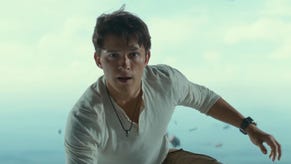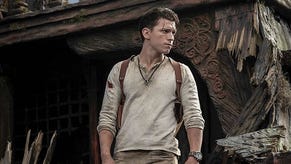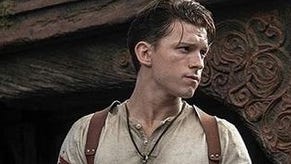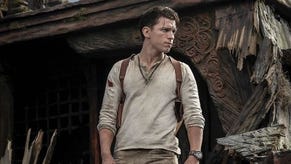Uncharted: Drake's Fortune
One to treasure.
On the whole, although the adventuring elements won't exactly stretch any grizzled hardcore platform puzzling veterans, there's something hugely impressive and graceful about Naughty Dog's approach to this element. Visually spectacular in a way that hints of a deep admiration of the vertiginous architectural splendour of Ico, the comparisons don't end there. It also shares that fluidity of the movement, albeit benefiting from a much more reliable, assured control system and more helpful camera system - such things are deserving of such a remarkable technical achievement. When the team reflects on the making of video that it has some of the most talented people in the business working for them, you'll believe it.
Gears of GRAW
As for the combat, it's similarly up to the same high standards set elsewhere. At first, though, this seems unlikely, with the initial boat raid giving you absolutely no hint as to how much fun the fire-fights will become later on. Within a few quick chapters shooting the array of hapless goons is, without doubt, compulsively entertaining. Borrowing from all the best equivalents of recent years, it plumps for an 'aim and fire' approach which feels somewhere between Resident Evil 4, GRAW and Gears of War, albeit slicker and with a far greater control over your character than all of them. Using L1 to aim and R1 to fire, the viewpoint switches from a basic third-person view to the now-fashionable over-the-shoulder style (albeit more dynamic, depending on where you are) giving you a nice close-up view of Nathan's choppy barnet.
But open-air combat is generally ill-advised, and the first thing you have to learn is that cover is king - and if you're exposed to enemy fire, you won't be able to take more than about half a dozen shots before the screen drains of colour and you're heading back to the most recent checkpoint. But by simply pressing circle next to a cover point - be it a low wall, crate or pillar - Nathan dynamically positions himself accordingly, meaning there's no need to crouch toggle or anything like that. Sidling up to the edge of your cover point, all you have to do is hold down the left trigger to pop out from behind it, and release it to go back into cover, making it a simple equation to safely loose off a few shots in the knowledge that you can nip back into a safe spot instantly.
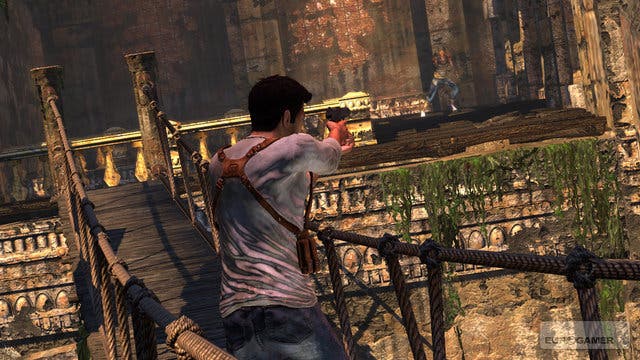
But that's not to say the game's enemies make it easy for you. One of the most impressive things about the game is the determined AI routines, showing again that Naughty Dog really isn't messing around with this game. Unlike so many tired, generic action games down the years, you get the impression that the enemies in Uncharted have been designed to properly flush you out from cover. They'll continually lob well-placed grenades, try to visibly outflank you, and often work as a team between cover points and try and get in behind you. It's maddening as hell to become the victim of your own stupidity when this happens to you, but you have to admire the mechanics at work that set these dynamic situations up. These guys aren't clueless borg that follow a set path, but visibly respond to the threat in front of them, changing their own tactics in relation to the cover point you decide to take up.
30 seconds of pun
Sure, Uncharted is full of repetitive combat mechanics, but just like Bungie's acclaimed '30 seconds of fun over and over' approach in Halo, Uncharted's combat is so well honed that there's never a point where you're groaning 'not again' just because you're facing the same sort of character models over and over. Being picky, I'd admit that enemy variety isn't the game's strong point, mainly because you're fighting men with pistols, assault rifles, shotguns, grenades, sniper rifles and other conventional firearms. The variety doesn't come so much from them but nor does it need to. The environments, scenarios and situations always seem to provide a fresh challenge, and there's never necessarily one set route to do it, so the combat still feels fresh by the end - mind you, with the game length clocking in at about the seven or eight hour mark, the game doesn't last long enough to ever get boring anyway, but that's another matter.
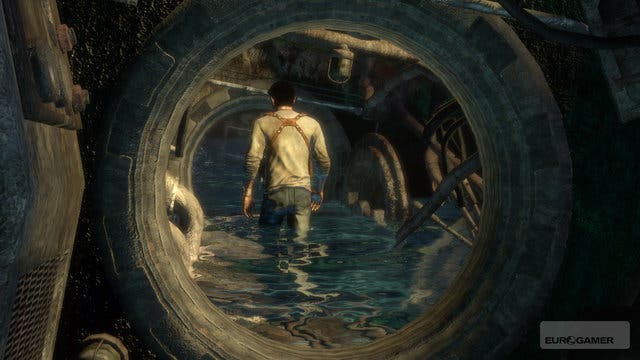
Talking of environments, it's hard to think of a single game that's ever included such lush and staggeringly detailed gaming environment. As much as Gears of War provided a stunning next-generation shooter setting, the moody greys and browns made it a harsh, dark, hostile, and monochromatic place to be. In Uncharted, it's not just superior to Gears in terms of out and out detail, but brings a feel-good factor with the sheer level of environmental variety on offer. Covering the full spectrum from 'destroyed beauty' to lush, tropical jungles (and all points in between), it has the kind of action adventure template that Eidos and Crystal Dynamics must be looking at with a great deal of envy right now. In truth, it may take years before rival brands find themselves with game engines as effortlessly capable as this one. Truly, Uncharted is the first game I've seen to date that makes me wonder if it could be done on the Xbox 360, and as a huge admirer of the software line-up on Microsoft's system, that's saying a lot. [And it's going to get us in trouble again. -Frowny Ed]


